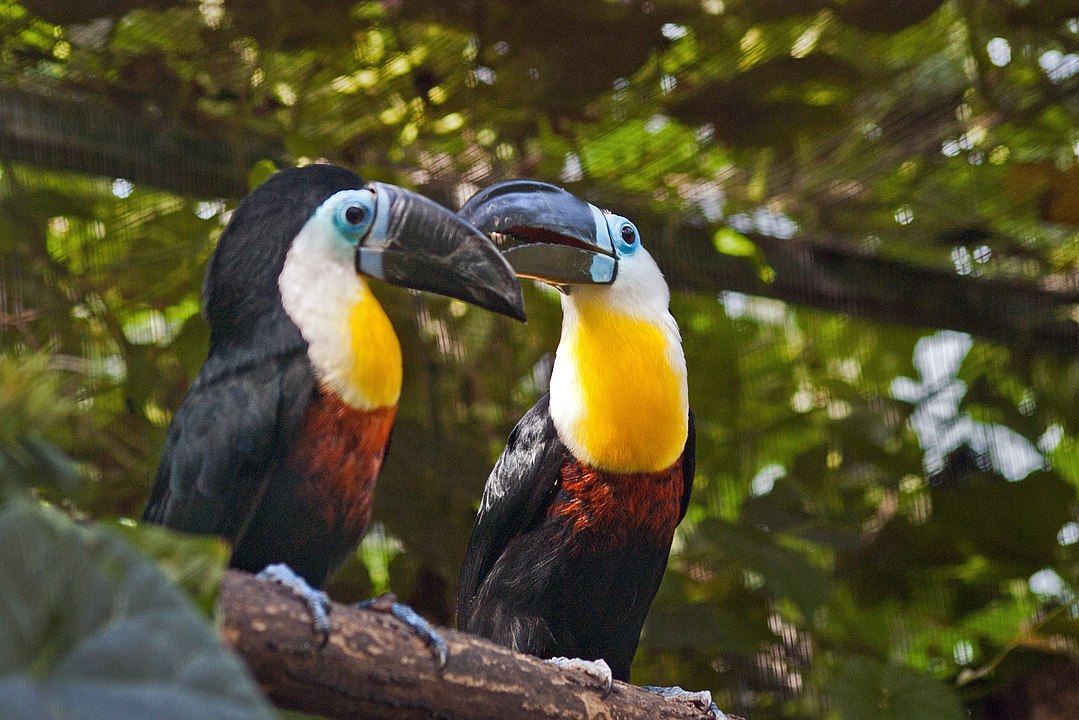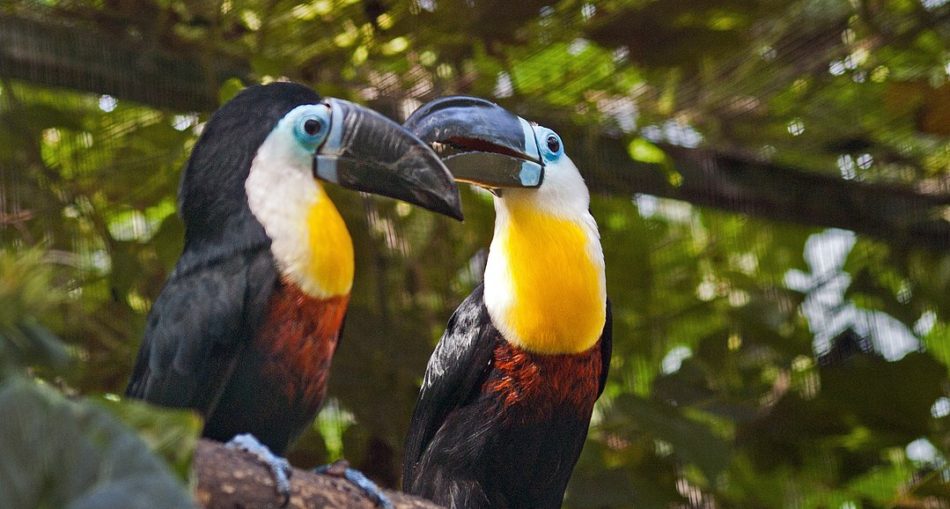What Do You Know About The Channel-billed Toucan?
Have you ever seen a bird with a gigantic bill, black body, yellow and white breast, bouncing from one branch to the other? Then it may be a Toucan. However, if it has baby blue bands on its face and red bands on the tail, you can be sure that it’s the Channel-billed Toucan Channel-billed Toucan (Ramphastos vitellinus) who rarely fly more than one hundred (100) metres at a time. There are three subspecies of the Channel-billed Toucan, which were formerly considered separate species. They are the Yellow-ridged Toucan, Citron-throated Toucan and the Ariel Toucan all of which interbreed freely wherever they meet. However, the Ariel Toucan subspecies is closer to the Channel-billed Toucan than to the nominate. The Channel-billed Toucan grows as big as four-eight (48) centimetres long and usually weighs between Three hundred to four hundred (300 – 400) grams. Read on to find out more about this unique creature.

The Channel-billed Toucan – Photo by By Daniel Jolivet – Saint-Aignan (Loir-et-Cher). Toucan ariel., CC BY 2.0, https://commons.wikimedia.org/w/index.php?curid=41024645
Where Does The Channel-billed Toucan Live?
The Channel-billed Toucans are usually found living in lowland forests and woodlands. While they typically prefer humid regions, they locally extend into drier areas, especially along rivers. The Channel-billed Toucan is native to Guyana, but you can find them in countries like Trinidad and Tobago, Brazil, Venezuela, Bolivia Suriname, French Guiana, in tropical South America.
Interesting Tip:
- Some species of a toucan are hunted for their meat and colourful feathers, but many local tribes regard them as mystical creatures that guide dead spirits from one world to the next. This means that they are traditionally protected.
Description of the Channel-billed Toucan
Most of the body of the Channel-billed Toucan is black, including the upperparts, belly, tail, and the bill while the upper tail and under tail coverts are red. The iris is a dark brown while the bare eye-patch and bill base is a beautiful baby-blue colour. Throats are white, while the central breast is yellow-orange fading to white alongside, and the lower breast sharply distinguishes with a broad transverse red band.
Male Coloration – The male Channel-billed Toucan is distinctive because it has slightly larger bills than females.
Female Coloration – The female bills are generally shorter, deeper, and sometimes straighter giving more of a blocky impression.
Scientific Classification of the Channel-billed Toucan
- Kingdom: Animalia
- Phylum: Chordata
- Class: Aves
- Order: Piciformes
- Family: Ramphastidae
- Genus: Ramphastos
- Species: R. vitellinus
Diet of the Channel-billed Toucan
The Channel-billed Toucans have short wings, which do not allow them to fly very far for food; they prefer to forage through the forest canopy by hopping from branch to branch, then making short, flap-and-glide flights to the next trees. These birds use their long bills like tongs or chopsticks to snip ripe fruit from the ends of thin branches where other animals cannot reach. Once they have a morsel, they toss it into the air, then catch and swallow it whole. A toucan’s long reach allows it to plunder tree cavities and nests in search of other birds’ eggs and chicks, and they will eat insects, frogs, and small reptiles as well.
Behaviour & Lifestyle of the Channel-billed Toucan
Each Toucan species is different, but the vast majority of Toucans are social. They live in groups, known as flocks. Flocks of Toucans spend their days roaming through the treetops in search of food and calling noisily to one another. Scientists think these birds are monogamous and continue to breed with the same mate year after year. More eyes are also more effective at spotting potential predators.
Croaking Call the Channel-billed Toucan
You can also spot a Channel-billed Toucan by the high-pitched, croaking cree-op cree-op cree-opcall sound that they make. The grown-ups court Channel-billed Toucans usually noisily squawking collectively, preening each other’s feathers (allopreening), and hurling fruits to each other. Males within a group of toucans may pursue each other or grapple with their bills to affirm dominance.
Reproduction of the Channel-billed Toucan
The females usually lay two to four eggs. There is a gestation period of 18 days, and the parents both incubate for fifteen (15) to sixteen (16) days. While these birds have a short incubation period, their nesting is longer. The parents are both active in raising the young. However, they can be impatient sitters, often leaving their eggs uncovered for hours at a time. Newborn toucans remain in the nest after hatching. They are blind and naked at birth, and their eyes open after about 3 weeks.
They have short bills and specialized pads on their heels to protect them from the rough floor of the nest. The feathers do not begin to expand until they are nearly four (4) weeks old. They are helpless and unable to leave the nest for about eight (8) weeks, dependent upon both parents to feed them. After this, the young can care for themselves. They begin to leave the nest after forty (40) to fifty (50) days, depending on size.
Did you know? The Channel-billed Toucans’ large bill helps to regulate body temperature. A toucan’s bill can reach over eighteen (18) centimetres in length and is also used to reach for food and break open bird nests.
The Channel-Billed Toucan Conservation Status
The Channel-billed Toucan is listed as vulnerable by International Union for Conservation of Nature (IUCN) the due to the decreasing number of birds in the species.
The Channel-Billed Toucan in Guyana
The Channel-billed Toucans are popular pets because of their beautiful bright colours. But what is fascinating about these creatures is that they are not endangered because they can adapt to man and other habitats, even though rainforests, their homes, are being destroyed. In fact, these colourful and magnificent birds that nature saw fit to bejewel the canopy of Guyana’s lush rainforest add supreme beauty and grandeur, representing some of the most precious and natural beauty that Guyana has to offer.
Articles References
- https://en.wikipedia.org/wiki/Channel-billed toucan
- https://abcbirds.org/bird/channel-billed-toucan/
- https://livingrainforest.org/learning-resources/channel-billed-toucan







